
Volume 32 - Autumn 2011
Designer Bookbinders of America......and how we got there
by Gavin Dovey
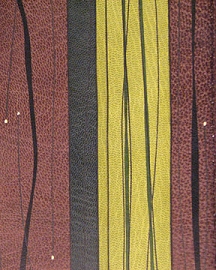
Many today compare the online revolution of the last decades to that of Gutenberg's moveable type, even the invention of writing itself. Even the most luddite among the members of the worldwide bookbinding society gave in and got themselves website's over the last decade, realising that resistance was indeed, futile. The world wide web, is an all pervasive intruder into the business and private lives of all global citizens today and yes, even bookbinders. Being one of the first generations to grow up using computers no matter how rudimentary, I and my fellow 'generation X' bookbinders have made the transition perhaps more easily than our forebears.
But there is more to the www than just touch typing and updating your website, such as the recent widespread use and application of social media, the ubiquitous Facebook, and the rise of the "blogger"
Since the 1990s many bookbinders have found the use of the Internet, websites and emails, indispensable to the day-to-day operations of business. You started with an advert in the yellow pages and answering phone calls and then began answering emails as well, so much so that the ringing phone would become for most an unnecessary nuisance.
Many others at that time were also making use of the many graphic applications, which over the last decade had consistently been improved and made easier to use; programs such as Illustrator, Photoshop and InDesign.
Now before you all switch off, try preparing a digital file for the die maker to produce a stamping die without Illustrator, or InDesign, or Adobe, or get a tool made at P+S....you can't ....and to go back, for the independent fine bookbinder would be a needless upheaval.
Many bookbinders have used and some now use them as an important design tool, in the creation of handmade books. In short, you'd find it pretty hard to graduate and stay in business anywhere in the world these days without learning the global language of computers and harnessing their potential for use in your work.
In 2008, after moving the bindery into a new building in Brooklyn, NY, I started to write a 'blog' and at the risk of offending everyone, a blog is simply an online journal, with its own web address onto which you can publish text, along side images.
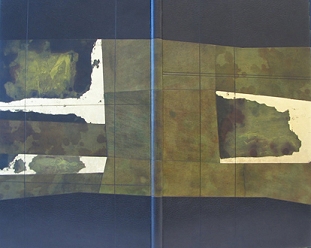 Binding by Gavin Dovey, USA
Binding by Gavin Dovey, USA
The main reason why I started was that as a person entirely ignorant of the basic 'html' code used to write websites, as well as the more exotic 'Flash' (now standard education for most young children), I, like most bookbinders, was subject to whim and mercy of my 'Internet Guy'.
This meant and still means today that the website built and launched in 2006, has been seldomly updated and has today no new content. I describe my current web page as 'static'. This may not be a problem for the more established and longer serving binders among us, as they have a body of work to rely on. But for the younger binder just starting out, this lack of ability to post new content or work to an online gallery can lead to stagnation, before you've gotten off the ground. Mark Winstanley at the Wyvern Bindery told me I should take pictures of everything I do, which is great advice, but you have to make sure people see that information too.
This is the great advantage of having and operating a blog....it is easy to use and does not require knowledge of computer code to run.
The effects were immediate and gratifying. The new work was a lot better than the stuff on the web I was unable to update. Posting was easy and each server (blogger, Wordpress etc.) provide for the custom design of templates.
The blog will afford you opportunities to add more interactive 'widgets' and capability to your site, making it more interesting for the visitor and also teaching some elemental html, which is obviously bound to come in handy. This allowed me, to embed videos onto the page, adding another great dimension to the site.
In the second year, I was able to learn some basic html in order start tracking visitors to the site, where they came from and what they looked at the most.
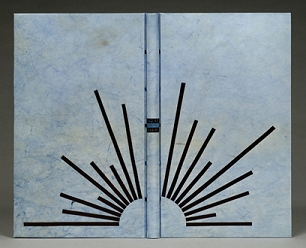 Binding by Peter Verheyen, USA
Binding by Peter Verheyen, USA
Now, it is all far too easy to get caught up with monitoring stats, with the desperate need of an addict. They can, however, be useful when getting to know your online audience, who they are, what work they are most interested in and where they are from. Its easy to come across a 20 something's fashion blog about the shoes they bought that day which has a daily audience in the tens of thousands.... that might give the lowly bookbinding blogs out there a sense of inferiority.....with the use of gimmicks such as hyperlinks, it is easy to get an audience, but I have found that getting the right online audience is far more prudent. As long as you post quality work that stands out and offers something in return for the visit, such as how-to's, you can generate a lot of activity, recognition and work.
Some of you might ask, 'all that's fairly interesting, but to what aim, do these people order anything from you?' Well, yes, and no - the aim is to build an audience, outside of the normal or more traditional venues, such as building a reputation in a trade bindery, which are all but extinct now, working under the mentoring and guidance of a master, which is only open to a few and entering into competitions, which again, in some cases are exclusive to nationality.
The blog accomplished more for my binding and business in the first few months, than the entirety of what the website had accomplished over a number of years. It remains the first focal point to which clients refer and has attracted a lot of interest and work- which is the important factor here. The power of this tool, wielded correctly can not be underestimated......keep the content good and give something away....let someone know how you did this or that...., it doesn't hurt.
In the first year of collecting stats from August 2010 - August 2011 it has had over 7,500 visits with about 80 or so items having been viewed approx 150,000 times from 1400 towns and cities, from 80 countries around the globe. The blog allows everyone good or bad to become their own journalist or publicist and this is fine for the bookbinder, as long as you have something to publicise. In order to write an interesting blog, you have to do the actual work. That always comes first. Don't write about how you feel, or what you had for lunch, nobody's interested, save that for Facebook, or Twitter if you're so inclined.
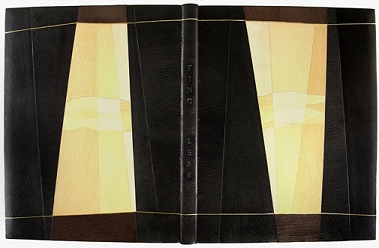 Binding by Sol Rebora, Argentina
Binding by Sol Rebora, Argentina
I discovered recently that Facebook does not have to be limited to keeping in touch with friends, or their dietary habits. Facebook provides community pages, in many formats, useful as a tool for binderies or book artists, or for communities of like-minded bookbinders to get together and share work and ideas.
Nowhere has this application been more useful for bookbinders with a common interest than in America. America is 2½ continents in one and in the case of the US, fragmented over 50 states, with thousands of miles between the more populated East and West coasts.
I do want to be clear that the US has many institutions and centres dedicated to the art of the book and many skilled binders. However, it has been clear to many that these institutions and centres are predominantly concerned with 'book art' and conservation, with small pockets offering education in fine binding, such as the American Academy in Telluride, Colorado. This coupled with the geography of the continent, can make it difficult for the young bookbinder on the make to improve their talents. This was certainly true in my case when I moved here in 2003 from England, which geographically speaking is highly concentrated in comparison, you are never more than a few hours on a train from anyone.
After some years, which had seen me open my first bindery and move into the second and after doing a lot of work and making many improvements and discoveries in my own skill, I started in 2008 to agitate for a set-book competition exclusively open for Americans. It turns out, that I wasn't the first. Voices of support were few and tinted with a slight cynicism. It seemed this road had been ploughed before and proved tough going....
Needless to say, my initial call generated some debate but then fizzled out without even a whimper! And so it was left, until June 2011, when after conversations and mutual encouragement from friend and binder Sean Richards (Byzantium studios, Oklahoma) we thought of trying a different tack. Recognising that the Guild of Book Workers, was not necessarily dedicated to bookbinding and that there was no American designer bookbinding organization, I decided to make my own....on Facebook.
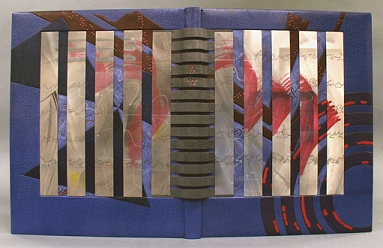 Binding by Donald Glaister, USA
Binding by Donald Glaister, USA
Once the page was set up, myself Sean, Amy Borezo (Shelter Bookworks Massachusetts) and Laurence Fayard, used Facebook and other online forums (philbiblon.com and the GBW listservs) to get attention for our cause. In 4 hours, binders from Toronto, Canada and Santiago, Chile, had signed onto the page, showing their support and sharing work. In the first few hours and days the most important matter, was to maintain the momentum, so that it wouldn't fizzle out and we did this by continually adding pictures to the page and finessing the site applications, to promote activity and generate comments, response and more members. Half-way through the first day, saw a lively debate between the very philosophical nature of the not yet existing organization, with myself and founder of the New York Centre of Book Arts, Richard Minsky. An organisation whose goal is to promote the very best in their chosen field, has to be, by its very nature, selective, which is a tough sell in the very democratic US
However, out of this fiery debate a mission statement and definition emerged which remains posted on our page today. I was told by a veteran that its better to start off with a narrow definition, because you can always broaden it afterwards, shrinking it is always difficult to do without marginalising existing members.
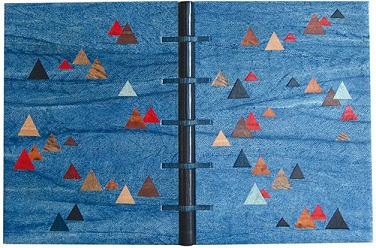 Binding by Louise Mauger, Canada
Binding by Louise Mauger, Canada
Having got the ball rolling, the next important step was to actively pursue participation from the more experienced, talented and established binders working within the continents. The next week and months we were very pleased to receive the active participation and support of such luminaries as Simone Benoit from Canada, Don Glaister, Monique Lallier, Deborah Evetts, James Reid-Cunningham, Richard Minsky and Peter Verheyen of the US, as well as Sol Rebora and others from South America.
There was an outpouring of support and pictures were being sent in from all corners of the continent, bringing to my attention at least the talents of bookbinders like Martin Farfan from Mexico, whose family have been bookbinders since the 1880's. The design work posted was incredibly diverse, as is characteristic of the differing cultural aesthetics of America and the support thus far has been very encouraging. Having established a contributing membership, pictorial content and bios were collected and posted on a website, that can be updated without a working knowledge of html. The site was purchased from a third party that provides the user with a template, which can be easily updated (CS template). As of July 2011 the site is live, including a blog that is accepting and showing demonstrations and work from North, South and Central America. We are currently accepting work for consideration for membership and we ask that people submit a bio and jpegs, the only qualification being that you must work in America! Marshall Mcluhan who many see as predicting the rise of the www, coined the phrase 'global village' and nowhere is this more apparent, than the ease of which we were able to facilitate connections and group activity, across continents, that may not otherwise have been possible.
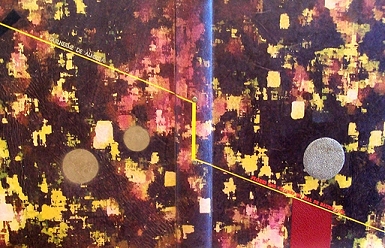
Binding by Marco Pedrosa, Brazil
We are in our third month, have a website, an active Facebook group and are currently in the process of applying for 501 3(c) status, as a charitable or 'non-profit' organization. The real test will be getting members together to submit work for our first show, which will not be easy. With the continued enthusiasm of our members and the work on behalf of this fledgling '.org' by Sean, Amy, Laurence and Sol, we can get together the first ever pan-American exhibition of design binding.
The important factor in all of my experiences thus far as a bookbinder in the US, has been the importance of social media like blogs and Facebook. As New York economist and writer Thomas L. Friedman maintains, while the planet may be round, the world itself is flattening.
Designer Bookbinders of America
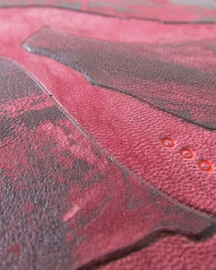
Gavin Dovey started bookbinding in 1998 with fellow of Designer Bookbinders UK (DB), Mark Cockram, and received a diploma in Design Bookbinding at the London College of Printing 2002. He then went on to work as a forwarder at the Wyvern bindery, London - as well as many other binderies in and around UK and Eire. Later he was fortunate to work along side fellow of DB- UK Paul C. Delrue at his bindery in Wales, UK. Gavin came to New York in 2003 to work in a Manhattan bindery and along the way taught some basic and advanced bookbinding at the Center for Book arts, The Chicago Center for Book and Paper Art and the Smithsonian institute. He started Paper Dragon Books and opened a store-front bindery in 2006, in the Chelsea area of Manhattan. He has since relocated to Brooklyn, where he continues to specialise in fine and design binding and box making for private libraries, museums, galleries as well as offering a variety of trade binding services for art and commercial presentation. Gavin continues to teach bookbinding from the bindery, run classes and take private students.
